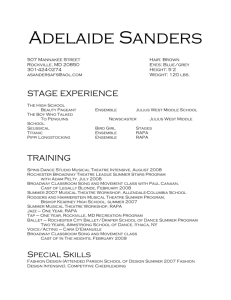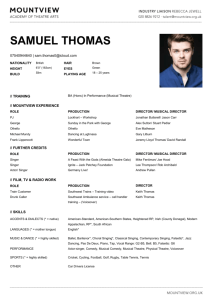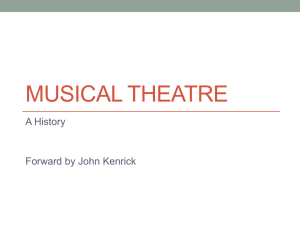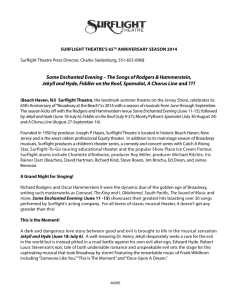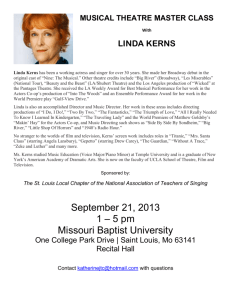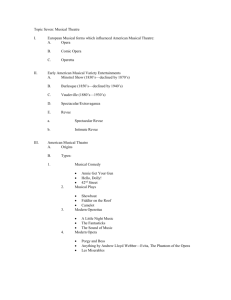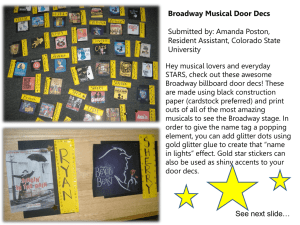Musical Theatre
advertisement
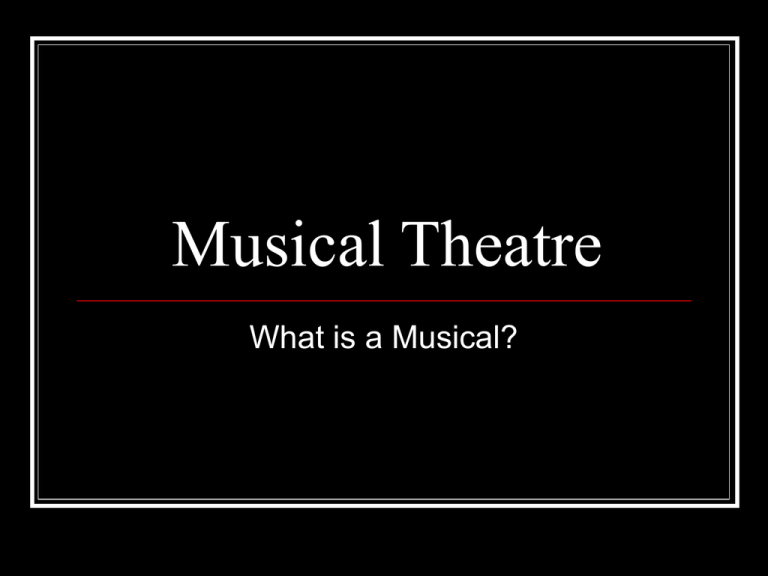
Musical Theatre What is a Musical? Musicals have gone by many different names Comic operas Operettas Burlesque Revues which have their roots in vaudeville, music halls and minstrel shows The Best Musicals have three essential qualities… Brains (intelligence and style) Heart (genuine and believable emotion) Courage (The guts to do something creative and exciting) Musical Theatre A Brief History Greeks Added music to their productions as early as the 5th Century B.C. The Greek Chorus sometimes included music (Aeschylus & Sophocles composed their own music but melodies no longer exist) Solos were not unheard of No direct effect on modern musicals but it shows that show tunes have been around for more than 2500 years Romans 3rd Century comedies of Plautus included song and dance routines with full orchestrations To make dance steps more audible in large open air theatres, actors attached metal chips called "sabilla" to their footwear – the first tap shoes Stress on spectacle and special effects, a trend that echoes into our own time Europe – Middle Ages Traveling minstrels and roving troupes of performers offered popular songs and slapstick comedy 12th and 13th centuries religious dramas, intended as liturgical teaching tools, used church chants, creating their own form of musical theatre Europe – Renaissance Minstrels reached their peak with Commedia Dell’arte in Italy with raucous clown characters improving their way through familiar stories Formal musical theatre was rare in the Renaissance, but Moliere turned several of his plays into comedies with songs when the court of Louis XIV demanded song and dance entertainments in the late 1600s Europe – 18th Century By the 1700s, two forms of musical theater were common in Britain, France and Germany ballad operas like John Gay's The Beggars Opera (1728) that borrowed popular songs of the day and rewrote the lyrics comic operas, with original scores and mostly romantic plot lines, like Michael Balfe's The Bohemian Girl (1845). Which brings us to the question… Are Musicals Descended From Opera? Opera has been with us since the late 1500s, but contemporary musical theatre and film are not direct descendants of grand opera. Opera can be called a descendant of classical theatre. When Renaissance writers and composers tried to resurrect the forms of Greek drama, they added music. This eventually led to the birth of grand opera. From its birth in the 1800s, the musical has often spoofed opera, but it traces its roots to other sources. Vaudeville, burlesque, and many other forms are the true ancestors of the modern musical -- not opera. Are Musicals Descended From Opera? Of course, the melodies of grand opera were part of the popular musical culture of the 1800s and early 1900s, and therefore had some effect on the musical theater melodies of that time. However, the so-called "comic operas" that dominated Broadway in the late 1880s and 90s, including the works of Gilbert & Sullivan, are not operas. Producers called these shows "comic operas" to make them sound more sophisticated, but with extended dialogue and melodies designed for the popular taste of that era, they were clearly musicals. Musical Theatre Gilbert and Sullivan Gilbert and Sullivan In the 1870s, William S. Gilbert and Arthur Sullivan revolutionized the musical theatre, creating witty, melodic operettas. Their songs sparkled with melody and clever rhyme, and Gilbert's librettos blended silliness and satire in settings that ranged from fantasy to the realistic. Producer Richard D'Oyly Carte publicized these shows as "light operas", but by any name, they were musicals – some of the finest the world would ever see. Gilbert and Sullivan - Beginnings Gilbert was an unsuccessful attorney before his comic poems appeared in popular magazines. This opened the way to a career as a playwright and director. Sullivan was Britain's most promising serious composer, but he woud compose lighter pieces to cover the expenses of his high-society lifestyle. In the 1860s, British musical theatre consisted of variety shows, French operettas, and slapdash comic light operas presented by John Hollingshead at The Gaiety Theatre. Trial by Jury (1875) Trial by Jury Hollingshead hired G&S to create Thespis (1871), a mythological spoof. Gilbert didn’t like it, but it impressed producer Richard D'Oyly Carte. 4 years later, he needed a one-act "curtain raiser" to share the bill with his production at London's Opera Comique. Carte convinced G&S to adapt one of Gilbert's satirical poems. Trial by Jury (1875) was a huge success This piece established several themes that run through most of Gilbert and Sullivan's shows – unqualified men who have oiled their way into high public office the course of true love flowing in surprising directions an appalling disdain for women over 40 years of age Gilbert and Sullivan – The Sorcerer D'Oyly Carte then persuaded G&S to attempt a full-length work. The Sorcerer (1877) involved a magician who wreaks havoc in a small English village with a love potion. Gilbert and Sullivan were developing a form of British operetta that was quite unlike its predecessors. They eliminated overt sexual references and replaced the cartoonish characters with more familiar, believable characters. Encouraged by The Sorcerer's profitable run, they then created an operetta that succeeded beyond their wildest dreams, with a show that reshaped the popular musical theatre on both sides of the Atlantic. HMS Pinafore (1878) HMS Pinafore (1878) H.M.S. Pinafore was the story of a naval captain's daughter who spurns the attentions of the First Lord of the Admiralty because she loves a common sailor, spoofing the Victorian class system. Pinafore was such a hit that D'Oyly Carte's investors tried to steal the production from him, sending thugs to carry off the sets and costumes in the middle of a performance! Since there was no international copyright laws, both Britain and the U.S. were flooded with Pinafore copycats. When G&S brought their company of Pinafore to New York, the casts of several unauthorized Pinafore's brazenly turned out to welcome them in the harbor. Pirates of Penzance (1880) Pirates of Penzance D'Oyly Carte secured the first international copyright by premiering The Pirates of Penzance (1880) simultaneously in New York and Great Britain. Pirates is the story of Fredrick, a young man who was accidentally apprenticed to a band of pirates. He falls in love with a Major General's ward and tries to atone for his past by plotting the destruction of his former comrades. When it turns out the soft-hearted pirates are really "noblemen who have gone wrong," they and a relieved Frederick marry the multitudinous wards of the rather "modern Major General." The success of Pirates confirmed Gilbert and Sullivan's place in popular culture. The amazing thing was that they were just getting started. The Rocky Road of Success G&S continued to turn out successes such as Patience (1881), Iolanthe (1882), but Princess Ida (1884) was not as well received so it closed early. D’Oyly requested another show to take it’s place. Gilbert submitted yet another plot involving a love potion, and when no amount of re-writing could make Sullivan accept it, the disagreement turned ugly. Sullivan declared that it was time for him to concentrate on more serious compositions, and Gilbert resented the suggestion that their collaboration was holding Sullivan back. The partnership was on the brink of collapse when a Japanese sword fell from the wall of Gilbert's study – inspiring the plot for their most popular show ever. The Mikado (1885) The Mikado The Mikado was influenced by an 1880s craze for “all things Japanese.” The complicated plot centers on what happens when the Emperor of Japan decrees that flirting is punishable by death. Because no one in the town of Titipu is willing to enforce this horrible law, a condemned tailor (Koko) is appointed Lord High Executioner – the reasoning being that he cannot behead anyone until he beheads himself. When it turns out he has to execute someone after all, he selects Nanki-Poo, a traveling minstrel. Nanki-Poo will only agree to the scheme if he can first marry the executioner's ward and finance, the lovely Yum-Yum. This will allow the minstrel a month of happiness, and the Executioner can then behead the man and marry his ward as planned. An aged woman (Katisha) from the royal court appears, announcing that Nanki-poo is really the crown prince who has been in hiding since he toyed with her affections! After a series of deceptions and misunderstandings, everything is resolved. The Mikado's Japanese setting and costumes masked the fact that it was a send-up of British customs and pretensions. In the United States, "Mikadomania" fed a nationwide American passion for all things Japanese. It remains one of the most frequently produced musicals of all time, and still receives new amateur and professional stagings worldwide. The Beginning of the End G&S’s following shows were not able to live up to the success of The Mikado. When it seemed Gilbert and Sullivan's collaboration was at its peak, it fell apart over several trivial disputes – including an infamous quarrel over the price of some new carpeting in the Savoy Theatre. After several years, the Savoy trio effected a reconciliation, but things were never quite the same. Gilbert and Sullivan's talents were intact, but both were losing the fresh creative edge. The Final Years G&S remained on cordial terms in their final years, and were both hailed by the public. When Sullivan received a knighthood in 1888, Gilbert was overlooked. The old collaborators worked on revivals and shared curtain calls at the opening nights. Sullivan continued composing classical pieces, and wrote comic operas with new librettists. Weakened by years of kidney trouble, he succumbed to a severe case of bronchitis in 1900 at age 58 years. Gilbert enjoyed renewed health and popularity in the new century, writing plays and musical librettos, and finally received his knighthood in 1907. In late May 1911, Gilbert (at age 74) suffered a fatal heart attack while saving a young woman from drowning on his country estate. After many years of illness, Richard D'Oyly Carte died in 1901. Musical Theatre Musical Theatre in America: The Minstrel Show Minstrel Shows The American musical has one shameful chapter in its history – minstrel shows. The most popular musical stage shows of the early and mid 19th Century, minstrelsy embodied racial hatred. Both white and black performers donned blackface, and audiences of all colors loved it. Hateful as it was, minstrel shows were the first form of musical theatre that was 100% American-born and bred. Minstrel shows developed in the 1840’s, peaked after the Civil War and remained popular into the early 1900s. In these shows, white men blackened their faces with burnt cork to lampoon Blacks, performing songs and skits that sentimentalized slave life on Southern plantations. Blacks were shown as naive buffoons who sang and danced the days away, gobbling "chitlins," stealing the occasional watermelon, and expressing their inexplicable love for "ol' massuh." Jim Crow Blackface acts were common features in circuses and traveling shows from the 1790s onwards. In the 1820s white entertainer Thomas "Daddy" Rice caused a nationwide sensation by wearing burnt cork to perform the song "Jump Jim Crow" on stage. He first heard it from an old black street singer who supposedly made up the lyric about his own name – "Jim Crow" turned out to be more than a popular song. It became a stock comedy character, and a by-word for legalized racial segregation. (Separate but Equal) Minstrel Shows Minstrelsy was the first example of the way American popular culture would exploit and manipulate AfroAmericans and their culture to please and benefit white Americans. As laws changed, several all-black minstrel companies toured America and Great Britain. Black performers still had to wear blackface makeup in order to look "dark enough," performing material that demeaned their own race. Despite such drawbacks, minstrelsy provided African American performers with their first professional stage outlet. Famous Minstrel Performers Amos and Andy Al Jolson Musical Theatre Musical Theatre in America: Burlesque Burlesque Beginning in the 1840s, these works entertained the lower and middle classes by making fun of (or "burlesquing") the operas, plays and social habits of the upper classes. Everything from Shakespearean drama to opera could inspire a full-length burlesque spoof. By the 1860s, burlesque relied on the display of shapely, underdressed women to keep audiences interested. In the Victorian age, when proper women went to great lengths to hide their physical form beneath bustles, hoops and frills, the idea of young ladies appearing onstage in tights was a powerful challenge. Burlesque Suggestive rather than bawdy, these shows relied less on strong scripts or songs than on sheer star power. When Broadway's The Black Crook became a massive hit in 1866, its troop of ballerinas in flesh-colored tights served notice that respectable American audiences were ready to fork over big bucks for sexually stimulating entertainment. At first, the American press praised burlesques, but turned vicious under pressure from influential do-gooders. But the cries of the self-righteous had an unintended effect. Editorials and sermons condemning burlesque as "indecent" only made the form more popular! Burlesque By the 1880s, wit was gradually replaced by a determination to reveal as much of the feminine form as local laws allowed. But obscenity and vulgarity were avoided – the point was to spoof, not to offend. Burlesque underwent a crucial change when Michael Leavitt produced burlesque variety shows using something similar to the three act minstrel show format – ACT ONE: The ensemble entertains with songs and gags, dressed in formal evening clothes. ACT TWO: An "olio" of variety acts (singers, comics, skits, etc.). ACT THREE: A complete one-act musical burlesque. These ranged from Shakespearean take offs like Much Ado About a Merchant of Venice to a Gilbert and Sullivan spoof called The Mick Hair-Do. Burlesque The biggest burlesque star of the early 20th Century was dancer Millie DeLeon, who tossed her garters into the audience and occasionally neglected to wear tights, which got her arrested on occasion, and helped to give burlesque a raunchy reputation. In time, burlesque bills began and ended with extended skits that made fun of hit shows and popular topics. In between came a variety olio where singers, comics, and specialty acts were all part of the mix. By the time most performers reached vaudeville, they were already experienced pros. While it was common for burlesque stars to graduate into vaudeville, vaudevillians considered it a fatal disgrace to appear in burlesque, insisting that only those who were "washed up" would stoop so low. However, many vaudeville veterans did burlesque during dry spells, appearing under an assumed name. Some famous comedians learned their craft working in burlesque, including future musical comedy stars Jackie Gleason, Bert Lahr, W.C. Fields, Red Skelton, and Bob Hope. Burlesque From the 1880s onwards, burlesque comedy was built around situations familiar to lower and working class audiences. Sexual innuendo was always present, but the focus was on making fun of sex. Some examples – (Injured Man crosses stage in assorted bandages and casts.) Comic: What happened to you? Injured Man: I was living the life of Riley. Comic: And? Injured Man: Riley came home! (Minister walks up to a beautiful young woman.) Minister: Do you believe in the hereafter? Woman: Certainly, I do! Minister: (Leering) Then you know what I'm here after. Many burlesque routines spoofed social conventions and linguistic idiosyncrasies. The most famous was Bud Abbott and Lou Costello's glorious "Who's On First," Musical Theatre Musical Theatre in America: Vaudeville Vaudeville By the 1880’s, half of the population was now concentrated in towns and cities, that left most of them with a little spare cash and weekly leisure time. People wanted affordable entertainment on a regular basis. Most variety shows were too coarse for women or children to attend, and minstrel shows were declining in popularity. Vaudeville also tried to bridge a social gap that had divided the American upper and lower class. Two Boston producers in 1883, using the fortune they made staging unauthorized Gilbert and Sullivan productions started building a chain of ornate theatres across the northeast. Vaudeville Presenting commercially successful "clean" variety shows, they instituted a policy of continuous multiple daily performances, which they called "vaudeville." As vaudeville spread through the United States, major theatre chains or circuits were built. All of them were run by tough businessmen, and all insisted that acts keep their material clean at all times. Headliners could bend the rules, but transgressions by lesser known performers were not tolerated. By 1907, Variety reported that vaudeville was earning $30 million a year. Vaudeville Appearing in vaudeville was hard. A successful act toured for forty plus weeks a year, doing "one nighters," or weekly stands. Performers put up with these demanding schedules because even those who did not reach the level of headliner could make good money. In 1919, when the average factory worker earned less than $1,300, a small time circuit performer playing a 42 week season at $75 per week earned $3,150 a year. Anyone with determination and a talent to entertain could earn a solid, respectable living. Few other fields could claim to offer the disadvantaged such accessible rewards in the early 20th Century. Vaudeville Acts More than 25,000 people performed in vaudeville over it’s 50-plus years of existence An act could be anything that was inoffensive and entertaining. A performer's gender, race and appearance were no barrier to success, and nothing was too eccentric. While singers and dancers were part of every bill, the specialty acts set vaudeville apart Among them were mind readers, escape artists - Houdini and his many imitators, high divers, strong men, contortionists, balancing acts, freak acts, and regurgitators - who drank liquids and then brought them back up. Hadji Ali would swallow water & kerosene, then spew kerosene onto open flames, followed by the water to put the flames out. Not pretty, but audiences were fascinated. The Decline of Vaudeville Many factors brought about the end of Vaudeville The advent of motion pictures was a devastating blow to vaudeville. Audiences also grew tired of the vaudeville format causing a sharp decline of ticket sales. The Great Depression also hit the vaudeville circuit pretty hard. Most vaudeville houses were converted to movie theatres and several circuit producers made the transition to movies as well. Many vaudeville performers were able to make the transition to radio and film. Famous Vaudeville Performers Judy Garland George Burns and Gracie Allen Famous Vaudeville Performers Eddie Cantor Sophie Tucker Famous Vaudeville Performers W.C. Fields Jack Benny Famous Vaudeville Performers Ma Rainey Bessie Smith Famous Vaudeville Performers Bill “Bojangles” Robinson Nicholas Brothers Famous Vaudeville Performers Will Rogers Charlie Chaplin Famous Vaudeville Performers Marx Brothers Buster Keaton Musical Theatre 1900 - 1920 1900’s By 1900 there were 33 Broadway theatres and many more on the rise. London was still the theatrical capital of the world and as a result most Broadway shows were from London. In 1904 the NY Subway opened allowing many more people to come to the theatre district Improved railroads also allowed Broadway shows to be shown around the country Everyone working in the theatre saw it as a business, not an art form. This meant that all shows had to appeal to the growing middle and working classes. Musicals were mostly upbeat celebrations of American knowhow and decency. And no one was more expert at providing such entertainments than George M. Cohan. George M. Cohan An Irish-American graduate of variety and vaudeville who wrote, directed, produced and starred in patriotic musical comedies that celebrated the triumph of American know-how and New York-style "street smarts." After limited runs on Broadway, where most critics frowned on Cohan's shameless, sentimentality, these musicals toured the U.S., drawing packed houses for a year or more. Cohan's most memorable hits included – Little Johnny Jones (Give My Regards to Broadway & Yankee Doodle Dandy) Forty-five Minutes to Broadway George Washington Jr. Florenz Ziegfeld & The Follies Ziegfeld made the revue format a huge success with his Follies in the early 1910’s. Ziegfeld spared no expense making Follies the costliest shows on Broadway. The 1907 edition was produced for a mere $13,800 -- the 1919 edition came in at $150,000, and the 1927 edition cost over $250,000. Although the emphasis was on spectacle and beautiful girls, the Follies introduced several memorable songs. Irving Berlin's "A Pretty Girl is Like a Melody" became the unofficial anthem for the series. The Follies biggest attraction was its line-up of comedic talent. Some of the funniest stars in show business achieved fame, including W.C. Fields and Will Rogers. The Follies would remain on Broadway through the late 20’s. Broadway & WWI When the U.S. entered the war in 1917 most Broadway stars played an active role at home. George M. Cohan wrote the mega-hit “Over There.” Al Jolson and other actors entertained the troops Few book musicals dealt with the war, but many musical reviews did. An influenza outbreak in 1918 almost wiped out commercial theatre across the nation, but NY kept their theatres open to very small crowds. At the end of the war, American pride ran high and brought about the “Roaring 20’s,” and Broadway was glad to oblige. The Actors Strike of 1919 The Post WWI boom was interrupted when the Actor's Equity Association demanded better working conditions for its members in response to abusive treatment by producers. It was common practice for actors to pay for their own costumes, to rehearse endless hours without pay, and to be fired without notice. In a patriotic gesture, Equity waited until after the war to press its demands. When producers refused to recognize the union, Equity called the first-ever strike in the history of the American theatre 1919. Producers tried to put together non-union casts to keep shows running until the stagehands union agreed to honor the strike, shutting down almost every professional production in the country. Faced with crippling losses, the producers were forced to recognize Actors Equity, finally giving actors professional leverage. Musical Theatre The 1920’s 1920’s The1920s were Broadway's busiest years, with as many as fifty new musicals opening in a single season. Record numbers of people forked over up to $3.50 a seat. Shows began to be written by craftsmen who took musical theatre seriously, trying to provide quality entertainment and make a profit at the same time. No, No, Nanette was one of the biggest hits of the 20’s Black Theatre during the 20’s Shuffle Along, also a huge hit, was produced, written and performed entirely by African-Americans. It gave major breaks to Josephine Baker and Paul Robeson Starting in 1926 a series of Blackbirds reviews were also successful with all black casts but produced by whites. By contemporary standards, these shows would seem offensive. Actors still wore blackface, and most of the comedy relied on old minstrel show stereotypes. With racial enlightenment was still more dream than reality in 1928, many African Americans embraced the show, realizing that a certain degree of bowing and scraping was necessary for the success of the performer. Musical Theatre New Composers of the 1920’s Rogers and Hart Gained fame with the review The Garrick Gaities Rodgers, Hart and Fields achieved even greater success with A Connecticut Yankee. Based on Mark Twain's tale of a modern American who dreams that he has been transported to King Arthur's legendary court. Their early shows were lighthearted romps, but some of their songs had surprising, bittersweet undertones. As the stock market crash of 1929 led to tough times on Broadway, Rodgers and Hart suffered a series of frustrating near hits and outright flops. When Paramount Pictures offered them a generous contract to create screen musicals, they took their talents out West. Cole Porter Cole Porter inherited a fortune, so he had little financial incentive to pursue a theatrical career. After his initial failure with the musical, See America First, (he quit and lived the high life in Europe for several years. Things changed in the 1920’s when he began working on a succession of worthwhile projects. The musical Paris had the daring song hit "Let's Do It," which led to the musical comedy Fifty Million Frenchmen, featuring "You've Got That Thing" and "You Do Something to Me." Porter's melodies ranged from bright to sensual, and his witty lyrics featured witty rhymes and daring sexual innuendo. The first Broadway lyricist to openly discuss sex in his songs, Porter would rise to fame in the 1930’s. George and Ira Gershwin George's rousing melody to "Swanee" won little attention in a mediocre Broadway revue, but then Al Jolson made it an international sensation. George quickly became one of the hottest musical talents in New York, and teamed with Ira on nine 1920s stage scores. Lady Be Good (1924) brought Broadway stardom to Fred Astaire. Oh Kay! (1926) was about a millionaire who doesn't realize that rum runners are using his mansion as a smuggling station. Funny Face (1927) featured a girl trying to get back her diary from her guardian, opening the way for a series of mishaps. Their librettos were little more than excuses to get from song to song, something they change in the next decade. Musical Theatre The Mega Hits of the 1920’s Good News (1927) Good News was not the first musical about college life, but it was such a hit that it established its own set of theatrical clichés. The plot about a football hero who has to pass an exam so he can play in the big game and win the girl he loves. The dance-happy songs included "The Best Things in Life are Free" and "The Varsity Drag," a Charleston-style dance number that became an international craze. Depicting the "roaring 20s" as people would like to remember it, this show remains one of the definitive theatrical events of 1920s. Al Jolson “The World’s Greatest Entertainer” Born in a Russian in the 1880s. His family emigrated to the U.S. and Asa Yoelson decided to become an entertainer and changed his name to Al Jolson. After winning fame in minstrel shows and vaudeville, Jolson made his Broadway debut at The Winter Garden Theatre where Jolson became the toast of New York. His shows toured the country for years at a time, making him a star from coast to coast. Jolson is best remembered today for his use of blackface, but he was not a racist. Sensitive to discrimination of all kinds, he championed the rights of black performers on several occasions. His career spanned stardom in minstrelsy, vaudeville, Broadway, Hollywood and radio. Showboat (1927) One of the most powerful and popular musicals ever written, Show Boat was the collaborative effort of three theatrical giants -- producer Florenz Ziegfeld, composer Jerome Kern and lyricist-librettist Oscar Hammerstein II. It told the epic tale of the inhabitants of a Mississippi show boat from the 1880's to the 1920s, it deals with racism and marital heartbreak – subjects that had been considered taboo in musicals. The ground-breaking libretto was matched by an innovative, character-driven score with such hits as "Make Believe," "Old Man River" and "You Are Love." Although many identify "Old Man River" with Paul Robeson, the song was introduced on Broadway by Jules Bledsoe. Showboat (1927) Show Boat was a tremendous gamble. Nothing like it had ever been tried on Broadway before, and Ziegfeld was wracked with doubts about the show's commercial prospects. Even so, he spared no expense, giving this sweeping saga the visual grandeur it needed to achieve optimal impact. After the opening night performance at the Ziegfeld Theater, a stunned audience filed out in near silence. Ziegfeld thought his worst fears had been confirmed. He was shocked when the next morning brought ecstatic reviews and long lines at the box office. Show Boat was an unqualified triumph, the most lasting accomplishment of Ziegfeld's career. This masterpiece spawned no trends, but it showed what musical theater could aspire to. With one silent and two sound film versions, as well as four acclaimed Broadway revivals, Show Boat's appeal has survived the test of time. Musical Theatre The 1930’s Broadway & The Great Depression 1930’s During the 1930’s, Broadway dealt with the last Vaudeville bill closing (1932), the Great Depression, and Radio & Movies. Radio was free, movies were only 5 cents, but Bway musicals were around $3 a seat. Producers kept theatre alive through bankruptcy and great personal sacrifice. Despite the turmoil, the 1930’s saw the Broadway musical reach new creative heights. Hits of 1930’s George & Ira Gershwin produced hits such as Strike Up the Band, Girl Crazy (Ethel Merman’s debut), Of Thee I Sing, and the famous Jazz-Opera Porgy & Bess. George died in 1937 but Ira continued to work in movies through the 1950’s. Rogers and Hart turned out several hits including The Boys from Syracuse (a musical version of The Comedy of Errors) and starring such stars as Ray Bolger, Ethel Merman, and Desi Arnez. Reviews continued to be popular but were redefined due to rising costs and slumping box offices. Hits of 1930’s Noel Coward (Britain’s only success in Broadway during the 30’s) turned out several hit revues and the hit comedy, Private Lives. The most popular composer of the 30’s was Cole Porter who wrote the hits; The Gay Divorce (“Night and Day”) Anything Goes (“I Kick Out of You”) and Red Hot and Blue (“Delovely”) With network radio offering all-star variety entertainment at no charge, revues became rare on Broadway in the 1940s, and eventually moved to the less expensive realm of Off-Broadway. Musical Theatre The 1940’s Broadway & World War II 1940’s With WWII and America still suffering echoes of the Great Depression, Broadway felt that audiences during the early 1940s wanted entertainment that provided an escape from reality, the more lighthearted the better. Cole Porter, Ira Gershwin and Irving Berlin continued to have several hits including Berlin’s military revue This is the Army (1942) As the 1940s began, great art was not the goal in musical theatre. Most producers and critics were convinced that good songs and good fun were all that theatergoers required. Rodgers and Hart split in 1942. Rodgers then teamed with Oscar Hammerstein II creating the most renowned creative partnership the American musical theatre has ever known. Oklahoma The plot involves an Oklahoma Territory farm girl of the early 1900s choosing whether she will go to a dance with the farmhand she fears or the cowboy she loves. This simple love story takes a jarring turn when the farmhand proves to be a psychopathic murderer who the heroic cowboy is forced to kill in self defense. Murder in a musical? Despite strong comic material and a healthy dose of romance, it was neither a typical musical comedy nor an operetta. This was something new – a fully rounded musical play, with everything dedicated to moving the story forward. Hammerstein had tried something similar in his libretto to Show Boat, but those characters were two dimensional and the plot relied on all sorts of old melodramatic devices. Oklahoma R&H insisted that the leads fit the characters rather than use “stars.” Since the play dealt with emotions that might sound awkward if spoken, R&H decided to use dance as an integral element and hired famed modern dancer Agnes DeMille, who insisted on selecting trained modern dancers in place of the standard chorus girls. The Pre-Broadway reviews were terrible. One critic stated; “No gags, no girls, no chance." After some major revisions, Oklahoma opened to rave reviews on Broadway setting records in NY and London. Initial backers gained 2500% on their investment. Oklahoma’s Impact Before Oklahoma, composers and lyricists were songwriters. After Oklahoma, they had to be dramatists, using everything in the score to develop character and advance the action. Everything in a musical now serves a dramatic purpose. Diverting dance routines of the past were replaced by choreography that helped tell the show's story. Past shows used stars to perform showstoppers that had nothing to do with the plot. Oklahoma rejected these ideas, tossing out anything which did not fit the plot or bring characters into sharper focus. Audience members now have compassion for the characters who are no longer one dimensional. Post - Oklahoma After Oklahoma, Rodgers did a revival of Connecticut Yankee and Hammerstein did Carmen Jones. They reunited to create Carousel (1945) Other big hits of the 40’s included On the Town, Kiss Me Kate, Annie Get Your Gun and the last big hit of the 1940’s was South Pacific (again by Rogers and Hammerstein) Another big advancement started in the 1940’s was the full cast recording released on vinyl and packaged to look like a “photo album.” South Pacific (1949) As the 40’s ended, New York was the center of the theatrical world, and the last musical hit of the decade was one of the biggest ever. R&H wrote South Pacific about a military nurse who falls in love with a Frenchman, and a Lieutenant who gives his heart to a Polynesian girl. Dealing with bigotry and set amid the tensions of WW II, it was a world away from previous musical comedies hits. It had a well crafted script, and a score that included "Some Enchanted Evening," "Younger Than Springtime," "Bali Hai," and "I'm In Love With A Wonderful Guy". There was almost no dance, more than one key love story, and the dramatic tension was not provided by an antagonist ("bad guy") or a "silly misunderstanding." South Pacific confirmed R&H’s command of the genre. It won the Tony for Best Musical and became the second musical to receive the Pulitzer Prize for Drama. Musical Theatre 1950’s The Golden Age of the Broadway Musical 1950’s During the 50’s, showtunes were a major part of popular music. R&H’s successes continued with the hits; The King and I, Flower Drum Song, and the Sound of Music. Other hits include; Guys and Dolls, The Music Man, The Unsinkable Molly Brown, Camelot, and the biggest hit, My Fair Lady. Directors became crucial figures in musical theatre. The old separations between acting, song and dance faded, replaced by a greater fluidity in the staging and structure of musicals. Stars of the 1950’s Jerome Robbins, coming from classical ballet, used dance as a story-telling device, making it as essential as the script and the score. He directed and/or choreographed many shows including; On the Town, The King and I, West Side Story, and Gypsy. Bob Fosse built on what Robbins & DeMille had begun, adding show biz razzle dazzle and unapologetic sex appeal. Fosse took the directorchoreographer's role to new heights for several decades. Stars of the 1950’s Leonard Bernstein, was a conductor of the New York Philharmonic. His blend of classical, pop and jazz styles so distinctly invoked New York that his three hit musicals were all set in that city. (On the Town, Candide, and West Side Story) Bernstein is considered one of the most remarkable personalities of the 20th Century. Mega-star actresses of the 50’s included; Mary Martin (Peter Pan & Sound of Music) and Ethel Merman (Gypsy). Musical Theatre 1960’s Sunset of the Golden Age 1960’s The Fantasticks (1960) became the longest running hit in off-Broadway history (17,162 performances) Mega-hits included; Hello Dolly, Funny Girl, Fiddler on the Roof, Man of La Mancha, Mame and Cabaret. These shows made superstars of Carol Channing, Barbara Streisand, Zero Mostel, Angela Lansbury, and Joel Grey. 1960’s During the 60’s Broadway musicals declined making steady work for actors a serious issue. The popularity of Rock music pushed showtunes out of the charts. Rock music found its way into Broadway with the politically charged Hair (Aquarius and Let the Sun Shine In) and the controversial Oh, Calcutta! Many claimed that the musical was dying but it was merely changing. Musical Theatre 1970’s 1970’s The Rock Musical continued with the hits; Jesus Christ Superstar, Godspell, Grease and The Wiz Fosse hit his stride in the 70’s by directing Pippin and Chicago. Flops of the 1970’s – Dude (1972 - 16) was a muddled story of God and Satan battling over a man's soul. The Broadway Theatre was converted into an arena-style performance space, but this expensive gesture could not make up for Dude's amateurish book and score. Despite having most of Hair's creative team on hand, the confusing show closed in two weeks, losing over a million dollars. – Via Galactica (1972 - 8) offered a futuristic story of social outcasts living on an asteroid. It was so incoherent that even a plot synopsis inserted in the program could not clarify what was happening on stage. Via Galactica was one of the first Broadway flops to lose more than a million dollars. – The Lieutenant (1975 - 9) was a rock opera inspired by the 1968 massacre of Vietnamese citizens in My Lai. Some critics raved for this passionate work, but few Americans wanted a musical reminder of a long, demoralizing war. It would be another sixteen years before a musical set in Vietnam would succeed on Broadway. Rockabye Hamlet (1976 - 7) was the most embarrassing nail in the rock musical's coffin. It was based on Shakespeare's classic drama about a fictional Danish prince avenging his royal father's death. Director Gower Champion staged the show like an all-out rock concert, and the result was such an incoherent mess that many found it hard to believe that Champion could have been responsible for it. The score included "He Got It in The Ear," and disgruntled audiences laughed when the despairing Ophelia strangled herself with a microphone cord. Bad rock and bad theatre, it closed in just one week. It was not until the late 1970s that rock and other pop idioms would again reach Broadway in an effective theatrical format. Stephen Sondheim – The Dean of Hollywood Composers A protégé of Oscar Hammerstein, Sondheim has become an icon of Musical Theatre, working with several other directors and composers, He has worked on some of the most famous shows of the 20th Century. With Leonard Bernstein he wrote the lyrics to West Side Story and with Julie Stynes’ he wrote the lyrics for Gypsy. With Harold Prince, he wrote lyrics for the classics; Company, A Little Night Music, Follies, and Sweeny Todd. He then teamed with James Lapine to create; Sunday in the Park With George, Into The Woods , Passion, and Assassins. Chorus Line (1975) Created by interviewing a series of actual Broadway chorus dancers, Michael Bennett wrote a riveting play where a director demands that his dancers share their most personal stories. In the finale “One,” the entire cast sings and dances in a rigid formation, which was a dazzling smash hit. Chorus Line won multiple Tony’s and became the longest running show on Broadway (6,137) until Cats. Many consider Chorus Line to be the greatest musical ever. The Late 1970’s Other hits of the 70’s include Annie and the revue Ain’t Misbehavin’, and the burlesque revue Sugar Babies. By the end of the 70’s cast albums were in decline and production costs for musicals soared past the $1,000,000 mark Andrew Lloyd Webber’s follow up to Jesus Christ Superstar was the 1979 smash hit Evita, leading to the British Mega-musicals of the 1980’s. Andrew Lloyd Webber Born to classical musicians, Webber began writing musicals at Oxford with classmate Tim Rice. He and Rice are responsible for the smash hits Joseph and the Amazing Technicolor Dreamcoat, and Jesus Christ Superstar Webber has also collaborated on Phantom of the Opera, Starlight Express and of course the longest running show on Broadway, Cats (7,485). Later shows such as Aspects of Love, Sunset Boulevard and Bombay Dreams have been much less successful. Musical Theatre 1980’s The Mega-Musicals 1980’s The beginning of the 80’s saw modest hits from revivals and new shows such as Nine and Little Shop of Horrors. The biggest hit of course was Cats. What made it so revolutionary was the marketing. Everything from T-Shirts to snow globes playing “Memory,” made the producers millions. On the opposite end, the 80’s also brought perhaps Broadway’s biggest flop; Carrie: The Musical, lasting a whopping 5 performances. 1980’s Other smash hits of the 80’s were Phantom (6,000+ still running), Into the Woods, and Les Miserables (6,680). With these mega hits came the trend of mega-spectacle with each new show trying to out each other with spectacle rather than substance. This trend hit it’s peak in the early 90’s with an actual helicopter “landing” on stage in Miss Saigon. Musical Theatre 1990’s The Corporate Musicals 1990’s The 90’s also started with modest hits such as Will Roger’s Follies, Secret Garden, Jelly’s Last Jam and Kiss of the Spiderwoman. Webber’s Aspects of Love and Sunset Boulevard had modest success Cameron Mackintosh followed Les Miz with Miss Saigon. But 1994 brought a new kind of theatre to Broadway… Walt Disney’s Beauty and the Beast (4,000+ and still running) Disney on Broadway With Beauty and the Beast, Disney was able to replicate exact copies all over the world in many different languages. Parents brought kids to a cleaner safer Broadway and with merchandise rolling in more than ever, Disney made billions. Disney elevated the trend with The Lion King (2,000+ still running) by opening a retails store next door and an ultra-modern Disney hotel up the block. The Corporate Musical People with no interest in theatre now flocked to Broadway and tickets began to sell out years in advance. Shows began to be produced by entertainment corporations and made to look slick, contain pop ballads, and be reproduced world-wide with ease. The average musical budget soared to $8,000,000. One of the biggest hits of the 90’s tried to break that mold. Rent (1996 2,600+ still running) Jonathan Larson’s Off-Broadway experiment was a calculated risk that paid off big for producers It went through multiple rewrites and would have gone through more if it weren’t for the tragic death of Larson on the show’s final dress rehearsal. Larson’s death brought the show an amazing amount of publicity and made the show a smash on Broadway Produced for a ¼ the price as The Lion King, and marketed worldwide, Rent brought large profits to producers. Other hits of the 90’s The complete revamping of two Kander and Ebb musicals Chicago and Cabaret were two of the biggest hits of the late 90’s Other hits include; Bring in Da' Noise, Bring in Da' Funk, Jekyll and Hyde, and Titantic Less successful were the remakes of the movies; Footloose and Saturday Night Fever, starting an ominous trend of movie remakes. Musical Theatre 2000 – Present The Future of Broadway 2000 - Present The 21st century started off well with The Full Monty, and The Producers and Disney’s Aida,. It also brought back the “jukebox musical” trend with Mamma Mia, Movin’ Out, and Jersey Boys. Other diverse hits include Wicked, The Color Purple, Spamalot, and The 25th Annual Putnam County Spelling Bee. So what does the future of Broadway hold? The Future? Many feel that Broadway’s outlook is grim. With the trend of musicals such as The Wedding Singer, Legally Blonde, Lestat, Xanadu, and just about every Disney musical ever made, it seems true. Production cost continue to skyrocket. The Producers was rumored to cost $10 million. Production costs are forcing ticket prices well over $100 per ticket. But is Broadway dead? Sondheim said it best… "You have two kinds of shows on Broadway – revivals and the same kind of musicals over and over again, all spectacles. You get your tickets for The Lion King a year in advance, and essentially a family comes as if to a picnic, and they pass on to their children the idea that that's what the theater is – a spectacular musical you see once a year, a stage version of a movie. It has nothing to do with theater at all. It has to do with seeing what is familiar. We live in a recycled culture . . . I don't think the theatre will die per se, but it's never going to be what it was. You can't bring it back. It's gone. It's a tourist attraction. But is Broadway Dead? Dead? Certainly not. But changing none the less. Broadway will continue to evolve and go through trends both up and down. Whether there will be a revival of content and substance or it will merely become Las Vegas East is yet to be seen. Oscar Hammerstein also said it best… "It is nonsense to say what a musical should or should not be. It should be anything it wants to be, and if you don't like it you don't have to go to it. There is only one absolutely indispensable element that a musical must have. It must have music. And there is only one thing that it has to be – it has to be good."
